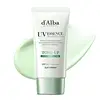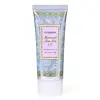D'Alba UV Essence Waterfull+ Tone Up Green Correcting Sun Cream SPF 50+ Versus Canmake Mermaid Skin Gel UV SPF 50+ PA++++
What's inside
What's inside
 Key Ingredients
Key Ingredients

 Benefits
Benefits

 Concerns
Concerns

 Ingredients Side-by-side
Ingredients Side-by-side

Water
Skin ConditioningDibutyl Adipate
EmollientDicaprylyl Carbonate
EmollientPropanediol
SolventButyloctyl Salicylate
Skin ConditioningTitanium Dioxide
Cosmetic Colorant2,3-Butanediol
HumectantDiethylamino Hydroxybenzoyl Hexyl Benzoate
UV FilterPolysilicone-15
UV FilterNiacinamide
SmoothingEthylhexyl Triazone
UV Absorber1,2-Hexanediol
Skin ConditioningPentylene Glycol
Skin ConditioningCentella Asiatica Extract
CleansingTuber Magnatum Extract
Skin ConditioningStellaria Media Extract
Skin ConditioningMorus Alba Root Extract
BleachingCitrus Aurantium Bergamia Fruit Oil
MaskingSimmondsia Chinensis Seed Oil
EmollientMelaleuca Alternifolia Leaf Water
AntimicrobialAbies Sibirica Oil
MaskingLavandula Hybrida Oil
EmollientCitrus Aurantifolia Oil
CleansingJuniperus Mexicana Oil
MaskingPelargonium Graveolens Flower Oil
MaskingPogostemon Cablin Leaf Oil
MaskingLitsea Cubeba Fruit Oil
MaskingMentha Viridis Leaf Oil
AstringentHydrogenated Lecithin
EmulsifyingSodium Hyaluronate
HumectantCoco-Caprylate/Caprate
EmollientVp/Eicosene Copolymer
Methylpropanediol
SolventPolyglyceryl-2 Caprate
EmulsifyingGlycerin
HumectantSucrose Stearate
EmollientAmmonium Acryloyldimethyltaurate/Vp Copolymer
Polyacrylate Crosspolymer-6
Emulsion StabilisingAlumina
AbrasiveHydroxypropyl Methylcellulose Stearoxy Ether
Stearic Acid
CleansingEthylhexylglycerin
Skin ConditioningPolyhydroxystearic Acid
EmulsifyingInulin Lauryl Carbamate
Emulsion StabilisingGlyceryl Caprylate
EmollientXanthan Gum
EmulsifyingAdenosine
Skin ConditioningTriethoxycaprylylsilane
Squalane
EmollientPolyether-1
Propylheptyl Caprylate
EmollientTocopherol
AntioxidantButylene Glycol
HumectantPanthenol
Skin ConditioningBiosaccharide Gum-1
HumectantLactobacillus Ferment
Skin ConditioningDimethylsilanol Hyaluronate
HumectantHydrolyzed Sodium Hyaluronate
Skin ConditioningHydrolyzed Hyaluronic Acid
HumectantPotassium Hyaluronate
Skin ConditioningHyaluronic Acid
HumectantSodium Hyaluronate Crosspolymer
HumectantHydroxypropyltrimonium Hyaluronate
Sodium Hyaluronate Dimethylsilanol
HumectantSodium Acetylated Hyaluronate
HumectantMadecassoside
AntioxidantAsiaticoside
AntioxidantAsiatic Acid
Skin ConditioningCaprylic/Capric Triglyceride
MaskingSucrose Distearate
EmollientHydroxypropyl Cyclodextrin
MaskingRetinal
Skin ConditioningChromium Oxide Greens
Limonene
PerfumingLinalool
PerfumingCitral
PerfumingWater, Dibutyl Adipate, Dicaprylyl Carbonate, Propanediol, Butyloctyl Salicylate, Titanium Dioxide, 2,3-Butanediol, Diethylamino Hydroxybenzoyl Hexyl Benzoate, Polysilicone-15, Niacinamide, Ethylhexyl Triazone, 1,2-Hexanediol, Pentylene Glycol, Centella Asiatica Extract, Tuber Magnatum Extract, Stellaria Media Extract, Morus Alba Root Extract, Citrus Aurantium Bergamia Fruit Oil, Simmondsia Chinensis Seed Oil, Melaleuca Alternifolia Leaf Water, Abies Sibirica Oil, Lavandula Hybrida Oil, Citrus Aurantifolia Oil, Juniperus Mexicana Oil, Pelargonium Graveolens Flower Oil, Pogostemon Cablin Leaf Oil, Litsea Cubeba Fruit Oil, Mentha Viridis Leaf Oil, Hydrogenated Lecithin, Sodium Hyaluronate, Coco-Caprylate/Caprate, Vp/Eicosene Copolymer, Methylpropanediol, Polyglyceryl-2 Caprate, Glycerin, Sucrose Stearate, Ammonium Acryloyldimethyltaurate/Vp Copolymer, Polyacrylate Crosspolymer-6, Alumina, Hydroxypropyl Methylcellulose Stearoxy Ether, Stearic Acid, Ethylhexylglycerin, Polyhydroxystearic Acid, Inulin Lauryl Carbamate, Glyceryl Caprylate, Xanthan Gum, Adenosine, Triethoxycaprylylsilane, Squalane, Polyether-1, Propylheptyl Caprylate, Tocopherol, Butylene Glycol, Panthenol, Biosaccharide Gum-1, Lactobacillus Ferment, Dimethylsilanol Hyaluronate, Hydrolyzed Sodium Hyaluronate, Hydrolyzed Hyaluronic Acid, Potassium Hyaluronate, Hyaluronic Acid, Sodium Hyaluronate Crosspolymer, Hydroxypropyltrimonium Hyaluronate, Sodium Hyaluronate Dimethylsilanol, Sodium Acetylated Hyaluronate, Madecassoside, Asiaticoside, Asiatic Acid, Caprylic/Capric Triglyceride, Sucrose Distearate, Hydroxypropyl Cyclodextrin, Retinal, Chromium Oxide Greens, Limonene, Linalool, Citral
Water
Skin ConditioningEthylhexyl Methoxycinnamate
UV AbsorberButylene Glycol
HumectantDiethylamino Hydroxybenzoyl Hexyl Benzoate
UV FilterZinc Oxide
Cosmetic ColorantMethylheptyl Isostearate
Skin ConditioningTitanium Dioxide
Cosmetic ColorantDimethicone
EmollientBis-Ethylhexyloxyphenol Methoxyphenyl Triazine
Skin ConditioningPolymethylsilsesquioxane
Cyclopentasiloxane
EmollientAmmonium Acryloyldimethyltaurate/Vp Copolymer
Diisostearyl Malate
EmollientAluminum Hydroxide
EmollientPEG-60 Hydrogenated Castor Oil
EmulsifyingStearic Acid
CleansingPhenoxyethanol
PreservativePolyglyceryl-3 Polydimethylsiloxyethyl Dimethicone
Skin ConditioningPolyhydroxystearic Acid
EmulsifyingJojoba Esters
EmollientXanthan Gum
EmulsifyingArginine
MaskingHyaluronic Acid
HumectantAlpha-Glucan
HumectantPhytic Acid
Saxifraga Sarmentosa Extract
Skin ConditioningGlucosyl Ceramide
Skin ConditioningPrunus Yedoensis Leaf Extract
Skin ConditioningCoix Lacryma-Jobi Ma-Yuen Seed Oil
Skin ConditioningMorus Alba Root Extract
BleachingOenothera Biennis Seed Extract
Skin ConditioningSilver Oxide
AntimicrobialSpiraea Ulmaria Flower Extract
Skin ConditioningVaccinium Myrtillus Bud Extract
AntioxidantCynara Scolymus Leaf Extract
Skin ConditioningWater, Ethylhexyl Methoxycinnamate, Butylene Glycol, Diethylamino Hydroxybenzoyl Hexyl Benzoate, Zinc Oxide, Methylheptyl Isostearate, Titanium Dioxide, Dimethicone, Bis-Ethylhexyloxyphenol Methoxyphenyl Triazine, Polymethylsilsesquioxane, Cyclopentasiloxane, Ammonium Acryloyldimethyltaurate/Vp Copolymer, Diisostearyl Malate, Aluminum Hydroxide, PEG-60 Hydrogenated Castor Oil, Stearic Acid, Phenoxyethanol, Polyglyceryl-3 Polydimethylsiloxyethyl Dimethicone, Polyhydroxystearic Acid, Jojoba Esters, Xanthan Gum, Arginine, Hyaluronic Acid, Alpha-Glucan, Phytic Acid, Saxifraga Sarmentosa Extract, Glucosyl Ceramide, Prunus Yedoensis Leaf Extract, Coix Lacryma-Jobi Ma-Yuen Seed Oil, Morus Alba Root Extract, Oenothera Biennis Seed Extract, Silver Oxide, Spiraea Ulmaria Flower Extract, Vaccinium Myrtillus Bud Extract, Cynara Scolymus Leaf Extract
 Reviews
Reviews

Ingredients Explained
These ingredients are found in both products.
Ingredients higher up in an ingredient list are typically present in a larger amount.
Ammonium Acryloyldimethyltaurate/Vp Copolymer (let's call it AAVC for short) is a synthetically created polymer. It's used as a film-forming agent and used to thicken the consistency of products.
AAVC is able to increase the consistency and viscosity of products due to its large molecule size. It also prevents ingredients from separating.
Butylene Glycol (or BG) is used within cosmetic products for a few different reasons:
Overall, Butylene Glycol is a safe and well-rounded ingredient that works well with other ingredients.
Though this ingredient works well with most skin types, some people with sensitive skin may experience a reaction such as allergic rashes, closed comedones, or itchiness.
Learn more about Butylene GlycolDiethylamino Hydroxybenzoyl Hexyl Benzoate (DHHB) is a chemical UV-A absorber. It is formulated for high UVA protection (320-400 nm).
DHHB is well-liked for:
DHHB has been approved by the EU, Japan, Taiwan, and South America for use up to 10%. Unfortunately, it has not been approved for use in the US or Canada due to slow regulatory processes.
This ingredient is soluble in oils, fats, and lipids.
Learn more about Diethylamino Hydroxybenzoyl Hexyl BenzoateHyaluronic acid is naturally found in healthy skin. It is a humectant, meaning it draws moisture to your skin.
This ingredient helps hydrate, soothe, and protect the skin.
What makes hyaluronic acid so hydrating? It has the capacity to bind or hold large amounts of water.
Fun fact: It is already naturally found in our bodies, such as the fluids of our eyes and our joints.
Studies find this ingredient to have anti-inflammatory and anti-microbial properties. This can help speed up wound-healing.
Hyaluronic acid can be irritating if the molecule has a low-molecular weight, or if the molecules are small.
One study found low-molecular weight hyaluronic acid to be pro-inflammatory, meaning some people may experience irritation. This is because our bodies use hyaluronic acid in the wound-healing process to signal to our bodies, via irritation, that something needs healing.
The same study found high-molecular weight hyaluronic acid to be anti-inflammatory.
These are some other common types of Hyaluronic Acid:
Learn more about Hyaluronic AcidWe don't have a description for Morus Alba Root Extract yet.
Polyhydroxystearic Acid is a soft wax made from castor oil.
It is is a texture thickener, emulsifier, and film-former. Emulsifiers prevent ingredients from separating, such as oils and waters.
Polyhydroxystearic Acid may not be fungal acne safe.
Learn more about Polyhydroxystearic AcidStearic Acid is a fatty acid. It is an emollient, emulsifier, and texture enhancer.
As an emollient, stearic acid helps soften skin. It aids the skin's protective barrier by preventing water loss. It also provides a gentle cleansing effect without stripping away natural oils.
Stearic acid may also be used to enhance the texture of products. It can add volume and stabilize ingredients such as water and oil. This can help water and oil ingredients from separating.
Sources of stearic acid include animal or vegetable fats/oils such as coconut or shea. It can be naturally found in butter, cocoa butter, shea butter, vegetable fats, and animal tallow.
This ingredient may not be Malassezia folliculitis, or fungal-acne safe.
Learn more about Stearic AcidTitanium dioxide is a mineral UV filter widely used in sunscreens and cosmetics.
It is one of only two UV filters officially classified as “mineral” by regulatory agencies, the other being zinc oxide.
Titanium dioxide provides broad-spectrum protection mostly in the UVB and UVAII range, with some protection in the UVAI range.
While its UVA protection isn’t as strong as zinc oxide’s, the difference is minor.
A common myth is that mineral UV filters reflect UV light. However, modern research shows titanium dioxide absorbs UV radiation like chemical filters (~95% absorption & 5% reflection).
Thanks to its non-irritating nature, titanium dioxide is suitable for sensitive, acne-prone, or redness-prone skin. It is unlikely to cause "eye sting" like other sunscreen ingredients.
A major drawback of this ingredient is its white cast and thick texture. This is why mineral sunscreens often leave a white cast and are less cosmetically elegant than chemical/hybrid sunscreens.
To improve white cast and spreadability, micronized or nano-sized titanium dioxide is often used.
There are ongoing concerns surrounding nano-titanium oxide's impact on marine ecosystems.
There is no conclusive evidence that any form of titanium oxide (or any other sunscreen ingredients) will cause harm to marine ecosystems or coral reefs. The science is still developing but many consumers are keeping a close eye on this issue.
Please note, many destinations have reef-safety sunscreen rules. For instance, the U.S. Virgin Islands advises all visitors to use non-nano mineral sunscreens.
Nano mineral sunscreens once raised safety concerns about absorption into skin.
Extensive research has shown that they do not penetrate healthy or damaged skin; they remain safely on the surface and the top layer of dead skin (stratum corneum).
You'll likely find titanium dioxide bundled with alumina, silica, or dimethicone. These ingredients help make titanium dioxide highly photostable; this prevents it from interacting with other formula components under UV light.
Learn more about Titanium DioxideWater. It's the most common cosmetic ingredient of all. You'll usually see it at the top of ingredient lists, meaning that it makes up the largest part of the product.
So why is it so popular? Water most often acts as a solvent - this means that it helps dissolve other ingredients into the formulation.
You'll also recognize water as that liquid we all need to stay alive. If you see this, drink a glass of water. Stay hydrated!
Learn more about WaterXanthan gum is used as a stabilizer and thickener within cosmetic products. It helps give products a sticky, thick feeling - preventing them from being too runny.
On the technical side of things, xanthan gum is a polysaccharide - a combination consisting of multiple sugar molecules bonded together.
Xanthan gum is a pretty common and great ingredient. It is a natural, non-toxic, non-irritating ingredient that is also commonly used in food products.
Learn more about Xanthan Gum